
Aeschynanthus is a genus of about 150 species of evergreen subtropical and tropical plants in the family Gesneriaceae. They are usually trailing epiphytes with brightly colored flowers that are pollinated by sunbirds. The genus name comes from a contraction of aischuno and anthos (flower). The common name for some species is lipstick plant, which comes from the appearance of the developing buds emerging from the calyces. A full list of the accepted species and their synonyms can be found in the Smithsonian Institution's World Checklist of Gesneriaceae.
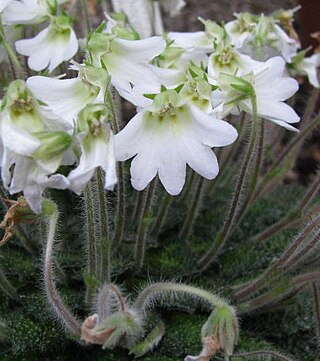
Petrocosmea is a genus of the family Gesneriaceae, the African violet family. Many of the species within this genus are endemic to high-elevation areas in Western China, although some are native to other parts of Asia. including north-central and southern China, Indochina, and the eastern Himalayas. It is a rosette-forming genus that generally grows on wet mossy rocks or forests.
Briggsia was a genus in the family Gesneriacae that consisted of 22 species of herbaceous perennials, native to the Himalayas, China and Vietnam. The genus is no longer recognized, with all of its member species having been relocated to other genera, including Glabrella, Loxostigma, and Oreocharis.
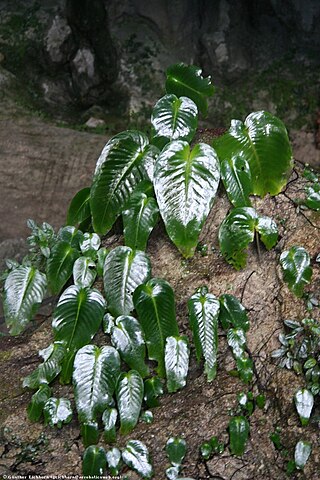
Monophyllaea is a genus of plants in the family Gesneriaceae. All the species only have one leaf.

Globba is a genus of plants in the ginger family: with delicate flowers, sometimes called "dancing ladies" or "dancing girls ginger". Species are native to the Indian Subcontinent, China, Southeast Asia, New Guinea, the Bismarck Archipelago and Queensland.

Rhynchoglossum is a genus of plant in family Gesneriaceae. In recent times, members of the former genus Klugia are also included. Species within the broader genus are found in India, southern China to New Guinea and about three species in tropical America. The genus has a leaf arrangement that is termed as alternate-distichous and the leaves are asymmetric in shape. The flowers have two lips. The older genus Klugia had four stamens compared to the typical two but Klugia from southern India are found to be very close based on molecular evidence.

Microchirita is a genus of flowering plants in the family Gesneriaceae, subfamily Didymocarpoideae. It contains 48 species native to tropical Asia, ranging from the Indian subcontinent to Indochina, southern China, and Malesia.
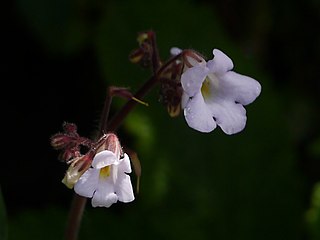
Henckelia is a genus of flowering plants in the family Gesneriaceae. Many of its species were formerly placed in Didymocarpus sect. Orthoboea and in the genus Chirita. Many species formerly placed in Henckelia have been moved to Codonoboea and Loxocarpus.

Codonoboea is a genus of flowering plants in the family Gesneriaceae. It includes 129 species which range from Myanmar and Thailand through northern Malesia to New Guinea.
Loxocarpus is a genus of flowering plants in the family Gesneriaceae. It includes 26 species native to Malesia, ranging from southern Thailand to Peninsular Malaysia, Sumatra, and Borneo. Many of its species were formerly placed in the genus Henckelia.
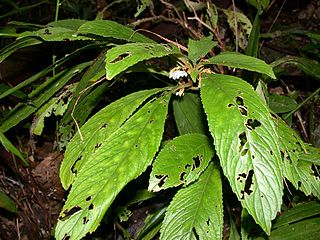
Rhynchotechum is a genus of plants in the family Gesneriaceae, subfamily Didymocarpoideae. Species distribution records are mostly from India, Sri Lanka, China through to southern Japan, Indo-China and Malesia through to New Guinea.
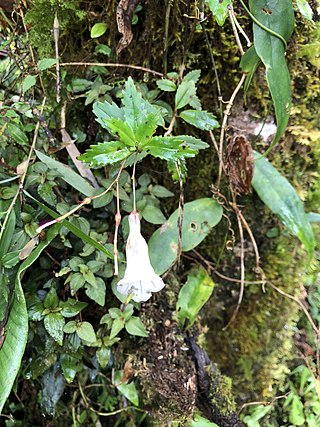
Lysionotus is a genus of flowering plants in the family Gesneriaceae. It occurs in the Himalayas, China, Japan, and Southeast Asia. The genus was described by David Don in 1822.
Paraboea are a genus of flowering plants in the African violet family Gesneriaceae, native to southern China, Assam, Indochina, and Malesia. They were recircumscribed from Boea in 2016.

Damrongia is a genus of flowering plants in the Gesneriad family, centered in Thailand and found in southern China, Southeast Asia, and Sumatra. Species were reassigned to it in 2016 in a revision of Loxocarpinae.
Tetraphyllum is a genus of flowering plants belonging to the family Gesneriaceae. As of April 2021, there was no consensus as to whether the correct scientific name for the genus is Tetraphyllum or Tetraphylloides, some sources using the former and some the latter.
Beccarinda is a genus of flowering plants belonging to the family Gesneriaceae.
Loxostigma is a genus of flowering plants belonging to the family Gesneriaceae.
Maharanga is a genus of flowering plants belonging to the family Boraginaceae.

Ornithoboea is a genus of flowering plants belonging to the family Gesneriaceae. It includes 17 species native to south-central China, Indochina, and Peninsular Malaysia.

Oreocharis is a genus of flowering plants in the family Gesneriaceae. It includes 154 species native to Asia, which range from the Eastern Himalayas and Tibet through Indochina and China to Japan.













